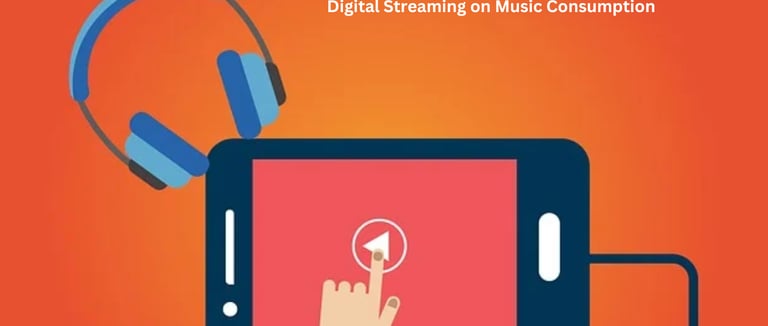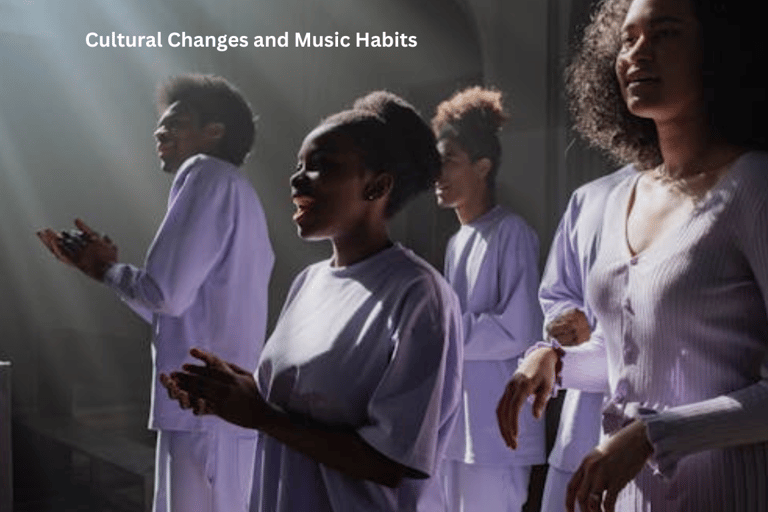The Impact of Digital Streaming on Music Consumption Analytical Books
1/24/20256 min read


"The Impact of Digital Streaming on Music Consumption: Analytical Books"
Changes have been dramatic regarding how music has been consumed in the last two decades. From vinyl records to cassettes, CDs, and now MP3 downloads, with every innovation comes a new map for music consumption; thus, everything is completely rewritten from there on, as concerns people's ways of accessing, sharing, and enjoying their music today. Pretty informative about the changes in the pattern of music consumption and what the changes mean in a more significant sense; analytical books on the subject are. Let's go deep into how digital streaming has transformed music consumption as told by renowned analytical texts.
1. The Emergence of Digital Streaming
Digital streaming services have changed how one consumes music-from Spotify to Apple Music, YouTube, and Tidal. Some very analytic books in that sense would be How Music Got Free by Stephen Witt; they can offer quite a fantastic viewpoint on changing the actual music formats themselves to their eventual digital form, due to this context, show that it was mainly technology that went into influencing said movement, as Witt illustrates how convenient and accessible content became from forces within the business that paved a path for how streaming rose in ascension.
These services can stream millions of songs to their customers with the same button click and even do this at an alarmingly reduced price compared with the entire album. Books like "The Spotify Play" by Sven Carlsson and Jonas Leijonhufvud add more to the saga of the music services in its rise into great popularity on the wave, rising from obscurity while battling the standard model of the music business.
2. Democratization of access to music
Maybe the most promising use of the technology is democratization-an analytical essay like "Streaming, Sharing, Stealing," which was engineered by Michael D. Smith and Rahul Telang that spelt procedure and impact levelling brought out amongst listeners within the earth as it will develop ease of access or facility, which has been deprived fans at their financial as well as geographic point of view is being stripped off finding his starting point, some starting point.
Similar services enable the free-thinking artist to bypass the record company. For instance, reviews by David Kusek and Gerd Leonhard in "The Future of Music" show precisely how streaming led artists to directly upload releases rather than have records sent to quaint little middlemen who kept artists locked from audiences.
3. Playlist Culture and decline of album
It has the culture of the "playlist ushered with this streaming." The book "Every Song Ever" by Ben Ratliff indicates how it might change the interface of the way the music speaks to the listener. Now it is no longer for an album-for they would like to listen to one particular song that best goes with their mood, activity, or preference.
However, this is very rewarding to the consumer. The critics always held on to this and criticized this trend as unsuitable for the albums' aesthetic appeal. "Retromania" by Simon Reynolds explains how the new trends are against the coherent, story-based album art at the centre of the music.
4. Data-Driven Music Recommendations
Algorithm-dependent music recommendation is paramount to determining if the listener has intrinsic tastes. Hence, analytical books like "The Song Machine" by John Seabrook focus on analytics with algorithms within the composition and marketing of the music. Of course, however, the algorithms, while seeming formidable, look in anticipation at what is being listened to. In other words, they are accurate in form. It is said the algorithms are to maximize the user's experience.
However, filtering exposure to those different genres remains controversial for those algorithms. Critics, as shown in Noah Giansiracusa's book How Algorithms Create and Prevent Fake News, present, through the "echo chambers," the truncation of musical discoveries due to stressors of familiarity instead of diversity.
5. Economic Impact on Artists
Analogically, digital TV has levelled up the playing fields, and for example, music offered the majority this opportunity but complicated the economic situation of musicians. Analytic books like "Goodnight iPad" by Ann Droyd Show quite a stark difference in revenue, that is, in the case of comparing how much sales are in the case of a physical album of revenue in that "streaming end."
To many artists, streams have been lost in this particular case. The books, including John Niven's "Kill Your Friends," seem like comedies as they offer very representative reviews of an artist's dilemma related to his financial condition.
6. Piracy and Copyright Issues
This does not signify that piracy entirely vanishes with the entrance of digital streams. However, Robert Levine's book Free Ride: How the Internet Destroyed the Music Industry and Saved It accounts for how copyright laws have traditionally been disadvantageous on technological grounds. Instead, it addresses some core concerns about the fair remuneration of artists and issues about the ethical problems of listening to music through digital channels.
7. Cultural Changes and Music Habits
It also was in a manner to influence a way a listener acted with yet digitized tastes in culture. The author, Mark Mulligan, of his book entitled "The Cultural Impact of Streaming" added: For since discoveries are at their end, further listening causes what's seen regarding change for attention for shorter because a listener's shorter tune-catches tend to hit a more significant amount of these days on a Top Charts that used to require mass for something more tangible.
These portals have changed the world music scenario, as K-pop and Afrobeat entered mass mainstream through them. Books like "BTS and Me" here describe how streaming allows inter-cultural flows and unifies the splintered fan bases.
Digital Streaming and Music Consumption (FAQS)
1. Music Digital Streaming: listening to audio from a source that offers services through an internet network rather than downloading the file. Some of the most significant services with huge libraries include Spotify, Apple Music, and YouTube. These services provide access to direct downloads via the internet, all for merely a few seconds.
2. Streaming has changed the way people listen to culture?
Because of streaming, one can hear almost any type of music within a few seconds because it makes it possible. Instead of listening to albums, a listener downloads songs or playlists to change how they listen.
3. Is the service paying the artist?
Streaming allows artists anywhere in the world to access their audience; most of the time, it is less expensive than a CD or record. For the artists, touring, merch, and sponsorships become their lifeblood.
4. Algorithms that are based on data-based streaming services ?
Data-driven algorithms: Algorithms with data based on them rely on logic, and therefore, a person who is being listened to with data-based history might have an impact toward their rises and make him satisfied through an increased number of end engagements.
5. Does that not allow the independent artist to stream?
Of course. It is so inherently because streaming grants independent artists a chance to hear one another without needing to clear the major labels. Of course, they do have to develop sustainable income-generating streams; however, these need to occur through the effective marketing of one's engagement with one's audiences.
6. How have playlists interacted with music use?
Playlists reign the streaming practice, where users create music for specific moods or occasion settings within activities or thematic purposes. These playlists have rewired listening habits around singles more than albums.
7. Compare the current with old streaming platforms regarding music trends?
Streaming platforms have changed the direction of music today. Today, something impossible in a world of global music can be entertained. The penetration of music into different places has allowed such websites. An entity such as K-pop, Afrobeat, or reggaeton would never have seemed imaginable earlier. This medium has also forgotten its cultural differences because the artists are letting their space open up by allowing the music penetration into the rest of the world.
8. Vinyl and other physical formats: just an old thing?
Not entirely, not too long ago, there was a revival of vinyl records. There is some nostalgic feeling, also physical. Streaming does not cancel the demand for physical formats, each with its own.
9. What is coming up in the future regarding digital streaming?
This means a more personalized user experience, far superior compensation models for the artists and even more ground-breaking music discovery and sharing technologies.
Conclusion
The whole world of music was changed around by digital streaming. It is changing the way they listen and enjoy their music. Analytical books abound in the information that can be dug for information related to the topic and very perceptible insights regarding its merits, demerits, and cultural importance. Since this is a change that has to come about, there has to be a middle ground that brings about technological developments with equal returns to the artists and artistic implications in music. This is more wonderful and better put when the formation of the soundtrack of our lives finds a stake within the role of digital streaming.







